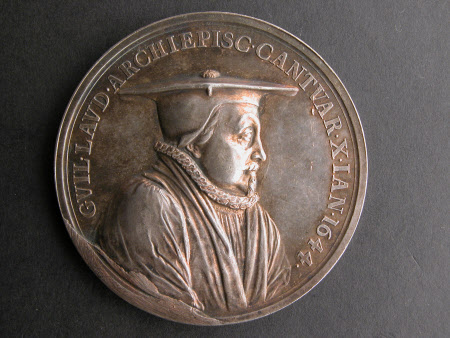Memorial medal for Archbishop William Laud
John Roettiers (1631- London 1703)
Category
Coins and medals
Date
1660 - 1685
Materials
Silver
Measurements
58 mm (Diameter)
Place of origin
London
Order this imageCollection
Osterley Park and House, London
NT 773259
Summary
Silver, Memorial medal for Archbishop William Laud, by John Roettiers (1631-1703), struck London, United Kingdom, 1660-85. A silver commemorative medal of Archbishop William Laud (1573-1645), by John Roettiers, made after the restoration of the monarchy in 1660. The obverse depicts Archbishop Laud facing right, wearing academic cap and robes, and a ruff. The inscription bears the date of his execution, 10 January 1644 (old style, i.e. 1645 new style). The reverse shows an angel carrying the mitre and crozier of Archbishop Laud towards heaven, with below this two more angels bearing the crown, orb and sceptre of King Charles I. At bottom is a panoramic view of London. The Latin legend translates as ‘Forerunner of the sainted Charles’.
Full description
William Laud (1573-1645) became one of the early victims of the political crisis that led to the English Civil War. Appointed Archbishop of Canterbury in 1633, his High Church and royalist views brought him into increasing conflict with Puritan forces in Parliament. He was arrested in 1641 and was executed in January 1645. This medal, made after the restoration of the Monarchy in 1660, commemorates Laud’s death. It may have been intended to form part of a series commemorating those who had suffered and died in the cause of the Church and the Stuart dynasty. In the design on the reverse, the deaths of Laud and Charles I are treated as martyrdoms, with both men shown symbolically ascending to Heaven. The legend seeks to draw an explicit parallel between the executed Laud and Saint John the Baptist, who was decapitated at the behest of Salome, daughter of King Herod. The comparison between the archbishop and the biblical figure of the Baptist caused some offence at the time. Examples of the medal are normally signed on the truncation by John Roettiers who, with other members of his family, came from Antwerp after the Restoration to work in the Royal Mint in London. The signature has been effaced on this example. Jeremy Warren, 2019
Provenance
Given to the National Trust in 1993 by George Child Villiers, 9th Earl of Jersey (1910-1998).
Marks and inscriptions
Obverse: GVIL.LAVD.ARCHIEPISC.CANTVAR. X. IAN. 1644 Reverse: SANCTI.CAROLI.PRAECVRSOR.
Makers and roles
John Roettiers (1631- London 1703), medallist
References
Hawkins, E. (ed.) Franks, A.W. and Grueber, H.A: Medallic Illustrations of the History of Great Britain and Ireland to the death of George II, 2 vols,. London, 1885, I, pp.315-16, no. 147. Mitchiner 1988-2007: Michael Mitchiner, Jetons, Medalets and Tokens, 4 vols., London 1988-2007, vol. III (British Isles circa 1588 to 1830), 1998, p. 1691, no. 80.7 (4918). Eimer 2010: Christopher Eimer, British Commemorative Medals and their Values, London 2010, p. 47, No. 145. Platt 2013: Jerome J. Platt and Arleen Kay Platt, The English Civil Wars: Medals, Historical Commentary & Personalities, 2 vols., London 2013, vol. II, pp. 189-91.

